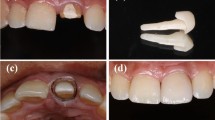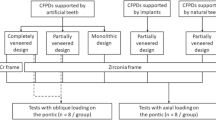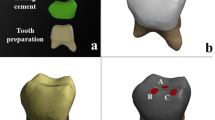Abstract
Objectives
This study aimed to evaluate a digital multi-piece zirconia post-crown to restore a mandibular second molar with extensive coronal loss and limited restoration space, and to compare the stress distribution between endocrowns made of zirconia or alloy and CAD/CAM multi-piece zirconia post-crowns.
Material and methods
Four three-dimensional finite element analysis models of a mandibular second molar with extensive coronal loss and limited restoration space were created as follows: (A) intact molar; (B) zirconia endocrown restored molar; (C) multi-piece post-crown restored-molar with tapered nail; (D) multi-piece post-crown restored molar with T-shaped nail. Models C and D were divided into two subgroups according to the material type: C1/D1, zirconia; C2/D2, NiCr alloy. The maximum modified von Mises failure criterion (mvM) stresses were calculated, and the stress distribution was recorded to analyze the effects of the restoration and material types on the biomechanical properties of dentin and prosthesis.
Results
The maximum mvM stress of dentin in model B (33.80 MPa) was lower compared with models C (C1, 37.81 MPa; C2, 36.36 MPa) and D (D1, 36.34 MPa; D2, 34.97 MPa) under vertical load, but the opposite was observed under oblique load. The highest mvM stress was concentrated in the nail region located in the root canal, and the T-shaped nail values were greater than the tapered nail, whereas model D with T-shaped nail showed a lower mvM stress level in dentin compared with Model C with tapered nail.
Conclusions
The digital multi-piece zirconia post-crown is a potential approach to restore mandibular second molars with extensive coronal loss and limited restoration space.
Clinical relevance
The digital multi-piece zirconia post-crown has potential to restore mandibular second molars with extensive coronal loss and limited restoration space using an innovative approach.







Similar content being viewed by others
References
Hanihara T, Ishida H (2005) Metric dental variation of major human populations. Am J Phys Anthropol 128:287–298. https://doi.org/10.1002/ajpa.20080
Pilloud MA, Hefner JT, Hanihara T, Hayashi A (2014) The use of tooth crown measurements in the assessment of ancestry. J Forensic Sci 59:1493–1501. https://doi.org/10.1111/1556-4029.12540
Cassetta M, Altieri F, Di Mambro A, Galluccio G, Barbato E (2013) Impaction of permanent mandibular second molar: a retrospective study. Med Oral Patol Oral Cir Bucal 18:e564–e568. https://doi.org/10.4317/medoral.18869
Goodacre CJ, Campagni WV, Aquilino SA (2001) Tooth preparations for complete crowns: an art form based on scientific principles. J Prosthet Dent 85:14. https://doi.org/10.1067/mpr.2001.114685
Govare N, Contrepois M (2020) Endocrowns: a systematic review. J Prosthet Dent 123(3):411-418.e9. https://doi.org/10.1016/j.prosdent.2019.04.009
Huang YC, Lin CL, Ko EW (2015) Effects of proximal grooves and abutment height on the resistance of resin-cemented crowns in teeth with inadequate resistance: an in vitro study. Biomed J 38:336–341. https://doi.org/10.4103/2319-4170.148905
Fei X, Wang Z, Zhong W, Li Y, Miao Y, Zhang L, Jiang Y (2018) Fracture resistance and stress distribution of repairing endodontically treated maxillary first premolars with severe non-carious cervical lesions. Dent Mater J 37:789–797. https://doi.org/10.4012/dmj.2017-203
Sedrez-Porto JA, de O da Rosa WL, da Silva AF, Münchow EA, Pereira-Cenci T (2016) Endocrown restorations: a systematic review and meta-analysis. J Dent 52:8–14. https://doi.org/10.1016/j.jdent.2016.07.005
Alcañiz M, Grau V, Monserrat C, Juan C, Albalat S (1999) A system for the simulation and planning of orthodontic treatment using a low cost 3D laser scanner for dental anatomy capturing. Stud Health Technol Inform 62:8–14
Parashis A, Tripodakis A (1994) Crown lengthening and restorative treatment in mutilated molars. Quintessence Int 25:167–172
Zou Y, Bai J, Xiang J (2018) Clinical performance of CAD/CAM-fabricated monolithic zirconia endocrowns on molars with extensive coronal loss of substance. Int J Comput Dent 21:225–232
Biacchi GR, Mello B, Basting RT (2013) The endocrown: an alternative approach for restoring extensively damaged molars. J Esthet Restor Dent 25:383–390. https://doi.org/10.1111/jerd.12065
Dartora G, Rocha Pereira GK, Varella de Carvalho R, Zucuni CP, Valandro LF, Cesar PF, Caldas RA, Bacchi A (2019) Comparison of endocrowns made of lithium disilicate glass-ceramic or polymer-infiltrated ceramic networks and direct composite resin restorations: fatigue performance and stress distribution. J Mech Behav Biomed Mater 100:103401. https://doi.org/10.1016/j.jmbbm.2019.103401
Zarow M, Devoto W, Saracinelli M (2009) Reconstruction of endodontically treated posterior teeth–with or without post? Guidelines for the dental practitioner. Eur J Esthet Dent 4:312–327
Helal MA, Wang Z (2019) Biomechanical assessment of restored mandibular molar by endocrown in comparison to a glass fiber post-retained conventional crown: 3D finite element analysis. J Prosthodont 28:988–996. https://doi.org/10.1111/jopr.12690
Forberger N, Göhring TN (2008) Influence of the type of post and core on in vitro marginal continuity, fracture resistance, and fracture mode of lithia disilicate-based all-ceramic crowns. J Prosthet Dent 100:264–273. https://doi.org/10.1016/S0022-3913(08)60205-X
Lü LW, Meng GW, Liu ZH (2013) Finite element analysis of multi-piece post-crown restoration using different types of adhesives. Int J Oral Sci 5:162–166. https://doi.org/10.1038/ijos.2013.50
Glantz PO (2000) Nilner K (1994) The devitalized tooth as an abutment in dentitions with a reduced but healthy periodontium. Periodontol 4:52–57. https://doi.org/10.1111/j.1600-0757.1994.tb00005.x
Glazer B (2000) Restoration of endodontically treated teeth with carbon fibre posts–a prospective study. J Can Dent Assoc 66:613–618
Luu KQ, Walker RT (1992) Corrosion of a nonprecious metal post: a case report. Quintessence Int 23:389–392
Meyenberg KH, Lüthy H, Schärer P (1995) Zirconia posts: a new all-ceramic concept for nonvital abutment teeth. J Esthet Dent 7:73–80. https://doi.org/10.1111/j.1708-8240.1995.tb00565.x
Habibzadeh S, Rajati HR, Hajmiragha H, Esmailzadeh S, Kharazifard M (2017) Fracture resistances of zirconia, cast Ni-Cr, and fiber-glass composite posts under all-ceramic crowns in endodontically treated premolars. J Adv Prosthodont 9:170–175. https://doi.org/10.4047/jap.2017.9.3.170
Dejak B, Młotkowski A (2013) 3D-Finite element analysis of molars restored with endocrowns and posts during masticatory simulation. Dent Mater 29:e309-317. https://doi.org/10.1016/j.dental.2013.09.014
Nakamura T, Imanishi A, Kashima H, Ohyama T, Ishigaki S (2001) Stress analysis of metal-free polymer crowns using the three-dimensional finite element method. Int J Prosthodont 14:401–405
Giannini M, Soares CJ, de Carvalho RM (2004) Ultimate tensile strength of tooth structures. Dent Mater 20:322–329. https://doi.org/10.1016/S0109-5641(03)00110-6
Ruse ND (2008) Propagation of erroneous data for the modulus of elasticity of periodontal ligament and gutta percha in FEM/FEA papers: a story of broken links. Dent Mater 24:1717–1719. https://doi.org/10.1016/j.dental.2008.04.006
Lin CL, Chang YH, Pai CA (2011) Evaluation of failure risks in ceramic restorations for endodontically treated premolar with MOD preparation. Dent Mater 27:431–438. https://doi.org/10.1016/j.dental.2010.10.026
Belli R, Wendler M, de Ligny D, Cicconi MR, Petschelt A, Peterlik H, Lohbauer U (2017) Chairside CAD/CAM materials. Part 1: measurement of elastic constants and microstructural characterization. Dent Mater 33:84–98. https://doi.org/10.1016/j.dental.2016.10.009
McComb D, Sirisko R, Brown J (1984) Comparison of physical properties of commercial glass ionomer luting cements. J Can Dent Assoc 50:699–701
Miura S, Yamauchi S, Kasahara S, Katsuda Y, Fujisawa M, Egusa H (2021) Clinical evaluation of monolithic zirconia crowns: a failure analysis of clinically obtained cases from a 3.5-year study. J Prosthodont Res 65:148–154. https://doi.org/10.2186/jpr.JPOR_2019_643
Tang W, Wu Y, Smales RJ (2010) Identifying and reducing risks for potential fractures in endodontically treated teeth. J Endod 36:609–617. https://doi.org/10.1016/j.joen.2009.12.002
Zurek AD, Alfaro MF, Wee AG, Yuan JC-C, Barao VA, Mathew MT, Sukotjo C (2019) Wear characteristics and volume loss of CAD/CAM ceramic materials. J Prosthodont 28:e510–e518. https://doi.org/10.1111/jopr.12782
Juloski J, Radovic I, Goracci C, Vulicevic ZR, Ferrari M (2012) Ferrule effect: a literature review. J Endod 38:11–19. https://doi.org/10.1016/j.joen.2011.09.024
Otto T, Mörmann WH (2015) Clinical performance of chairside CAD/CAM feldspathic ceramic posterior shoulder crowns and endocrowns up to 12 years. Int J Comput Dent 18:147–161
Dartora NR, de Conto Ferreira MB, Moris ICM, Brazão EH, Spazin AO, Sousa-Neto MD, Silva-Sousa YT, Gomes EA (2018) Effect of Intracoronal depth of teeth restored with endocrowns on fracture resistance: in vitro and 3-dimensional finite element analysis. J Endod 44:1179–1185. https://doi.org/10.1016/j.joen.2018.04.008
Guazzato M, Albakry M, Ringer SP, Swain MV (2004) Strength, fracture toughness and microstructure of a selection of all-ceramic materials. Part II Zirconia-based dental ceramics. Dent Mater 20:449–456. https://doi.org/10.1016/j.dental.2003.05.002
Eraslan O, Aykent F, Yücel MT, Akman S (2009) The finite element analysis of the effect of ferrule height on stress distribution at post-and-core-restored all-ceramic anterior crowns. Clin Oral Investig 13:223–227. https://doi.org/10.1007/s00784-008-0217-5
Owen TA, Barber M (2018) Direct or indirect post crowns to restore compromised teeth: a review of the literature. Br Dent J 224:413–418. https://doi.org/10.1038/sj.bdj.2018.218
Sahafi A, Peutzfeldt A, Asmussen E, Gotfredsen K (2004) Retention and failure morphology of prefabricated posts. Int J Prosthodont 17:307–312
Pontius O, Nathanson D, Giordano R, Schilder H, Hutter JW (2002) Survival rate and fracture strength of incisors restored with different post and core systems and endodontically treated incisors without coronoradicular reinforcement. J Endod 28:710–715. https://doi.org/10.1097/00004770-200210000-00008
Heydecke G, Butz F, Strub JR (2001) Fracture strength and survival rate of endodontically treated maxillary incisors with approximal cavities after restoration with different post and core systems: an in-vitro study. J Dent 29:427–433. https://doi.org/10.1016/s0300-5712(01)00038-0
Eskitaşcioğlu G, Belli S, Kalkan M (2002) Evaluation of two post core systems using two different methods (fracture strength test and a finite elemental stress analysis). J Endod 28:629–633. https://doi.org/10.1097/00004770-200209000-00001
Piconi C, Maccauro G (1999) Zirconia as a ceramic biomaterial. Biomaterials 20:1–25. https://doi.org/10.1016/s0142-9612(98)00010-6
Ozkurt Z, Işeri U, Kazazoğlu E (2010) Zirconia ceramic post systems: a literature review and a case report. Dent Mater J 29:233–245
Silva LS, Verri FR, Lemos CAA, Martins CM, Pellizzer EP, de Souza Batista VE (2021) Biomechanical effect of an occlusal device for patients with an implant-supported fixed dental prosthesis under parafunctional loading: A 3D finite element analysis. J Prosthet Dent 126:223.e1-e8. https://doi.org/10.1016/j.prosdent.2021.04.024
Mendonça JA, Francischone CE, Senna PM, Matos de Oliveira AE, Sotto-Maior BS (2014) A retrospective evaluation of the survival rates of splinted and non-splinted short dental implants in posterior partially edentulous jaws. J Periodontol 85:787–794. https://doi.org/10.1902/jop.2013.130193
Funding
This study was funded by the National Natural Science Foundation of China (grant number 81970927); the Medical Research Projects of the Health Department of Jiangsu Province (grant number M2020066); the Priority Academic Program Development of Jiangsu Higher Education Institutions (grant number 2018–87).
Author information
Authors and Affiliations
Corresponding author
Ethics declarations
Ethical approval
All procedures performed in the studies involving human participants were in accordance with the ethical standards of the institution and/or national research committee and with the 1964 Helsinki declaration and its later amendments or comparable ethical standards.
Informed consent
Informed consent was obtained from all individual participants included in the present study.
Conflict of interest
The authors declare no competing interests.
Additional information
Publisher's note
Springer Nature remains neutral with regard to jurisdictional claims in published maps and institutional affiliations.
Jiaxue Yang and Fei Han contributed equally to this work.
Supplementary Information
Below is the link to the electronic supplementary material.
Supplementary file2 (MP4 571 KB)
Rights and permissions
About this article
Cite this article
Yang, J., Han, F., Chen, C. et al. Comparison of stress distribution between zirconia/alloy endocrown and CAD/CAM multi-piece zirconia post-crown: three-dimensional finite element analysis. Clin Oral Invest 26, 5007–5017 (2022). https://doi.org/10.1007/s00784-022-04470-5
Received:
Accepted:
Published:
Issue Date:
DOI: https://doi.org/10.1007/s00784-022-04470-5




